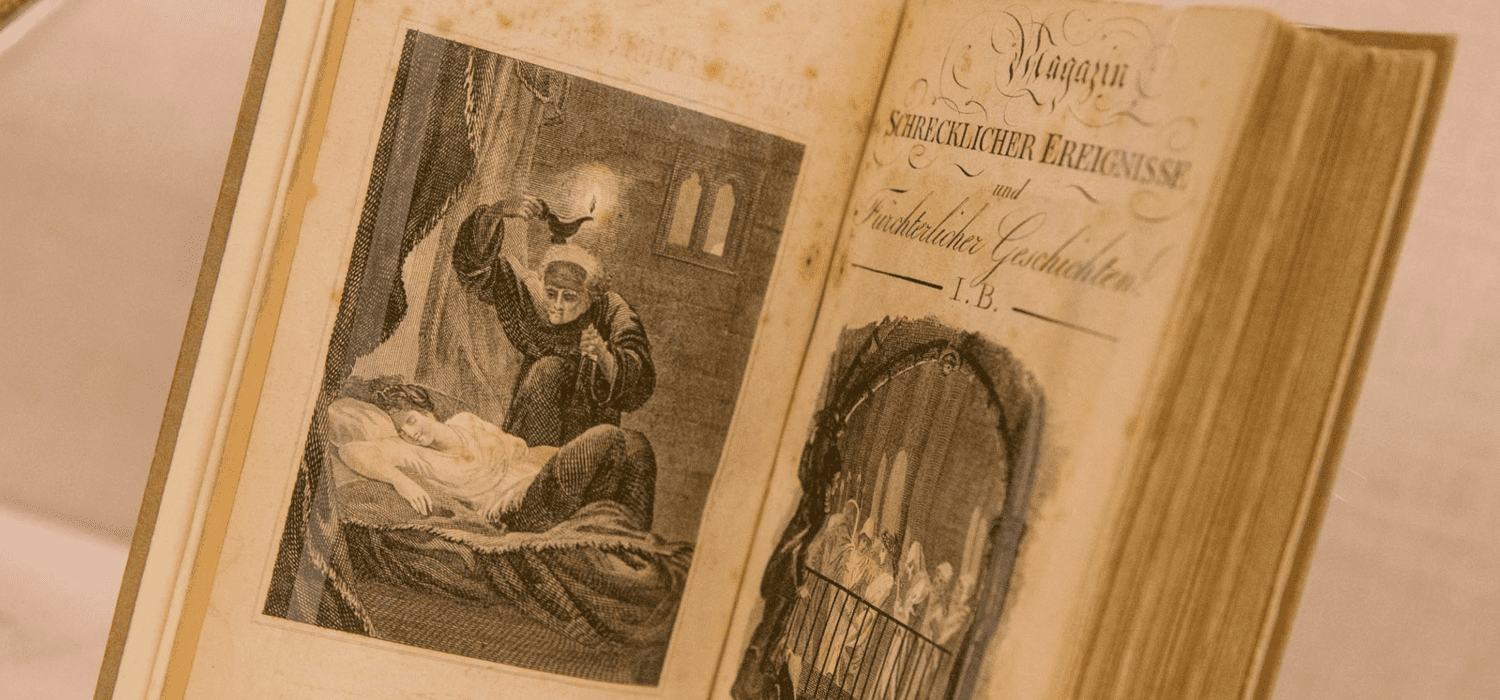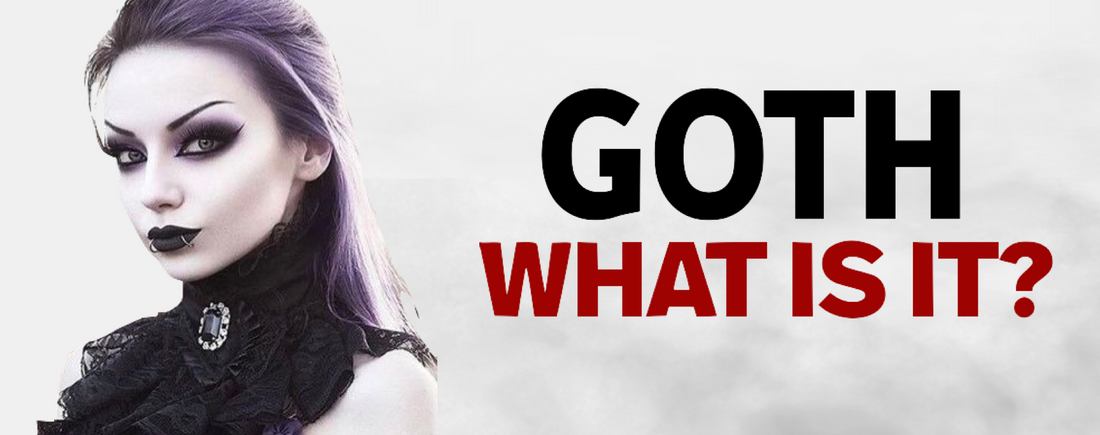While the term Goth can mean a lot of different things from wearing all black outfits to being overly emotional on social media, but, before the internet happened, Goth meant something very specific.
Goth is many things in our world. It's a Germanic tribe, a style of architecture, a type of literature and movies, a Fashion Trend, a musical genre and a youth movement. But, originally, Goth was a subset of the UK punk scene that describes itself with a profound fascination and love for the Darkness and the Macabre, where they see real beauty in them.
While many people think that any youth dressed in black with a fondness for obvious makeup can be called "Goth", it is clearly not that simple. So as the night's grow increasingly cold and dark, join us and discover what can be, has been and what is Goth today.
A brief history of Goth to answer some popular questions surrounding this thematic and to help you understand more precisely how it all started.
This is how Goth became Goth: #intro
Where did the term Goth originate?
The term Goth initially originates from Germanic tribes of people called the Ostrogoths and the Visigoths from the 4th century. At the time, the European territory was mostly controlled by the Romans who considered these tribes strange, barbaric and therefore dark and undesirable. But although they share the same name, there seems to be no real connection between these two groups of individuals. However they gave their name later to a certain type of art.
Gothic Art
While the terms Goth and Gothic tends to describe a specific type of individuals dressing with dark clothes in most people's subconscious, Goth is also different types of art old from several centuries such as Architecture, literature, painting, sculpting and much more.
Gothic Architecture

Later, the term "Gothic" became a type of architecture very present in the Middle Ages and whose best-known characteristics were lots of pointed roofs, flying buttresses, ribbed vaults, and gargoyles statues exposed at the tops.
This type of architecture was called "Gothic" during the Renaissance because it was supposedly connected with the Germanic tribes listed above and because people perceived the Middle Ages as times of darkness and ignorance; which is in association with barbarism.
Same as before, there is also no evidence that Gothic architecture was in any way connected to Germanic tribes.
Gothic Painting

Gothic Painting in is a current that appeared during the 13th century, almost 50 years after the beginning of Gothic architecture and sculpture. Transition from Romanesque to Gothic occurs in England and France around 1200, in Germany around 1220 and Italy around 1300.
Most of the paintings performed during the Gothic period were made in 4 different supports such as frescos, manuscript illumination, stained glass and panel paintings.
Gothic Literature and Fiction

During 18th and 19th centuries, the word "Gothic" was again used to describe a genre of literature called Gothic fiction, which combined elements of romanticism with horror and terror. The term comes from the first novel of this kind, The Castle of Otranto by Horace Walpole, which he subtitled "A Gothic Story."
Other famous examples include Bram Stoker's Dracula, Mary Shelley's Frankenstein, Charlotte Bronte's Jane Eyre, and everything by Edgar Allen Poe. Some historians think that this genre of literature was described as "Gothic" because most of the stories and plots took place in buildings with Gothic Architecture.
Nowadays, this type of literature has become its own genre with its own characteristics such as dark, spooky atmosphere and horrific events.
Goth Subculture History

After all this introduction, you're now ready for the most important part of this article, the beginning of the Goth Subculture.
When did Goth start?
While it was part of other subcultures like the Post-Punk movement, the first time that the term "Goth" was used to describe a distinctive subculture was in August 1979 when Bauhaus released their nine and a half minute long masterpiece Bela Lugosi's dead; making Joy Division's bleakness with Susie's aggressive sensuality and igniting a youth culture phenomenon.
Beyond a wealth of classic literature, the first Goth as we know it was probably Suzi Sue who, even before the banshees, was already tweaking Punk fashion by adding more fishnets more eye makeup and increasingly bigger hair.
The Goth Movement
As the Goth movement flourish throughout the early 80s, they established post-punk groups like The Cure who began playing up their moodier sides.
Newer bands like the Sisters of Mercy, The Birthday Party and Christian Death joined in to help turn by vampiric vibes into a full-blown movement.
As the scene grew, the sound diversified as well. There were the dreamy moods of the Cocteau Twins and much of the 4AD label at the time. Death Rock which got up the 80's Rockabilly revival and Dark Wave which happened when Goths inevitably collided with the industrial death scene.
Goth reached the peak of its pop cultural influence in the 90's with the popularity of Nine Inch Nails, The Crow, and The Sandman all of which helped lead a new generation of disaffected teenagers down the path of sad poetry and Goth makeup.
Goth crossover success since led to its downfall. Those that got mixed up with New Metal and Third-wave emo eventually lead to the birth of other types of Goths that completely turn down the spirit and almost killed the symbolism of this subculture by making it mainstream and less interesting.
But even as Goth was reaching its lowest point, the seeds for its resurrection were already being sown. Today, Rock is Goth but Rap is Goth too. TV and movies are Goth, Fashion is super Goth, Snapchat is Goth if you use the right filter.
Find anything in the world and someone will figure it out how to make it Goth and that is the spirit of being a true Goth, take anything average and mainstream and turn it into something darker.
What is a Goth person?
As explained previously, a Goth person is someone who feels and seeks beauty in things that others consider as dark. Death, Nightmares, blood, black cats, crows, all these things that are considered as taboo by most humans are what drives the true spirit of a Goth.
However, it doesn't mean that Goths are bad people, on the contrary. Goths have their own point of you on life and always seek to think outside the norm to feel this feeling of liberty and truth.
They are not brutal, they are not nasty and don't practice strange rituals in their basements (or at least not the majority of them). Being a Goth person is finding happiness in the less shiniest things because they see some beauty in it.
Much Goth persons are very artistic, romantic and very intelligent. Lots of them have master degrees from College, have their own businesses and share their subculture with positivity without denigrating other ways of thinking.
Finally, Goths don’t always wear black and dark clothes, and black is not the color code of Gothic fashion. So you see, being a Goth person isn't only referred on how you dress but much more how you think.
What does being Goth mean?
Being a Goth means many things, but, first of all, it means that you have a certain affection for Darkness and things that others consider as dark. In our world, lots of things are depicted as bad, dark or malicious due to cultural or religious superstitions.
Being a Goth is being able to not stay stuck in those easy way of thinking because most people do it that way. They are able to learn and sense things objectively outside the confirmation bias.
What do Goths believe in?
While most people think that Goths worship Satan, evil spirits or any other reincarnation of Lucifer, most of them are far from this definition. Indeed, Goth beliefs are much more based in aesthetic, art and psychology than any other social group. They aren't a cult as they don't worship any divinity or prophet.
Furthermore, Goths believe in the beauty that shines outside of the Darkness.
Why do Goths wear crosses?
The main reason why Goths wear crosses is because it is part from the catalog of accessories that comes with Gothic Clothing. Most Goths think it's cool to wear a cross as they look nice and become it is the reification of torture.
Moreover, wearing a cross is a sign for Goths that they believe in afterlife as some of them have been raised catholics, and it doesn't mean that they support any devil. However, if Goths wear inverted crosses, it means that maybe he/she have an interest in Satanism but most of the time, it's just a fashion accessory.
Is Goth Dead?
Although this subculture may be less present than at the time, Goth and Gothic Fashion are still strongly alive. Some even say that decades after it was born, Goth is better than alive, it is Undead.

